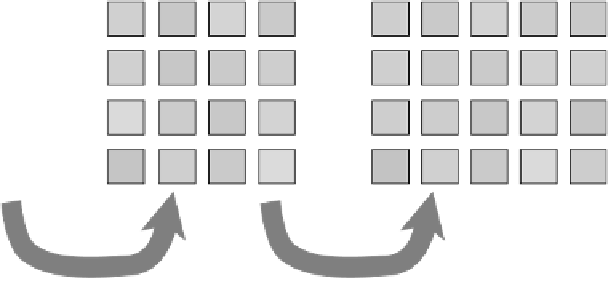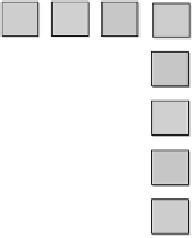Biomedical Engineering Reference
In-Depth Information
fingerprint characteristic of that antigen. Such a mutant BR matrix sensor would operate
with great sensitivity and selectivity. In this way, the need for highly optimized BR mutant
proteins is eliminated by the use of multiple mutants with unique and varied responses,
enabling a far more accurate determination. Furthermore, the “mutant matrix sensor”
would be capable of differential identification of various chemical agents, giving a differ-
ent numeric fingerprint for each agent to which the sensor is exposed—this detection
scheme can be thought of as a biochemical “nose,” capable of differentiating between var-
ious external chemical stimuli. Increasing the number of mutants used in the detection
matrix will result in a higher confidence level for the identification. The introduction of
highly optimized BR mutants produced through directed evolution will only enhance con-
fidence levels further.
The mutant matrix would be designed and operate as illustrated in Figure 14.8. An
array of individual sensor elements, each containing a different BR mutant, is exposed to
a chemical antigen. Upon exposure, the sensor elements are exposed to light and moni-
tored individually for their photokinetic response—in this case the kinetics of the M and
O intermediates are recorded. Each intermediate can produce as many as three numeric
matrices, including rise time, decay time, and photoelectric response, all specific to chem-
ical species interacting with the sensor. The resulting numeric fingerprints can be used to
identify the specific chemical toxin through database comparison. For situations in which
the sensor is exposed to multiple toxins, signal deconvolution techniques, such as signa-
ture analysis, will be used to parse out the signals for identification. The M and O matri-
ces will be fit to exponential formation and decay functions to provide a set of four
matrices, two for each intermediate—these sets represent a numerical signature that will
be different for each chemical antigen. Using signature analysis, the datasets can be
manipulated mathematically to provide a numerical correlation coefficient with reference
Matrix of random BR mutants
in resting state
Rise and decay of M-state after
exposure of the matrix to light
Rise and decay of the O-state after
M-state decay
16.3
5.4
15.6
64.7
23.8
1065
746
823
415
115
10.7
4.6
91.4
4.9
69.4
85.2
75.7
45.3
36.7
55.1
7.5
74.6
76.8
82.3
7.1
364
75.1
88.6
62.9
58.3
35.5
45.2
52.3
34.9
107
327
784
548
150
484
28.9
3.8
11.3
2.6
2.3
623
36.7
864
148
56.8
h
The bacteriorhodopsin mutant matrix sensor: BR mutant protein-based sensor elements
are activated by light, and the resulting photocycle kinetics for the M- and O-states can be
used to identify the chemical interacting with the sensor.
FIGURE 14.8
The sensor elements contain a random variety of bacteriorhodopsin mutants that are characterized by individ-
ual and specific responses to any given chemical species interacting with the sensor matrix. The matrix is illu-
minated upon exposure to a chemical (e.g., industrial pollutants, chemical warfare agents, and toxins), and the
BR mutants' photocycle into the M state. Upon the decay of M, the O state is formed. Kinetic parameters (M- and
O-state rise and decay time constants) are determined and the resulting matrices constitute a numeric signature
specific to the chemical interacting with the matrix.










